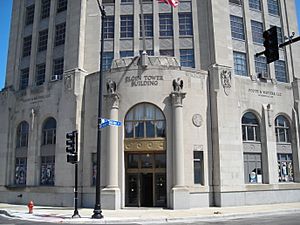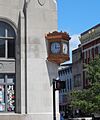Elgin Tower Building facts for kids
Quick facts for kids |
|
|
Elgin Tower Building
|
|
|
U.S. Historic district
Contributing property |
|

The Elgin Tower building in Elgin, Illinois
|
|
| Location | 100 E. Chicago St., Elgin, Illinois |
|---|---|
| Built | 1929 |
| Architect | W. G. Knoebel |
| Architectural style | Art Deco |
| Part of | Elgin Downtown Commercial District (ID14001067) |
| NRHP reference No. | 02000542 |
| Added to NRHP | May 22, 2002 |
The Elgin Tower Building is a tall, historic office building in downtown Elgin, Illinois. It was first called the Home Banks Building. This tower stands 186 feet tall and has 15 floors. It was built in 1929 for the Home National Bank and Home National Savings and Trust.
The bank did well at first. But then the Great Depression hit, causing big problems for the bank just months later. After World War II, the tower became successful again. This was because people needed more goods from Elgin. However, this good time did not last. The tower faced difficulties in the 1960s, especially after the Elgin National Watch Company closed in 1965.
Later, William R. Stickling bought the tower. He worked hard to fix it up. After he passed away in 1999, the building was given to a charity named after him. The William R. Stickling Charitable Foundation still takes care of the building today. Fixing up the tower is a big part of making downtown Elgin better. The Elgin Tower is one of only two buildings in Elgin built in the Art Deco style. It was added to the National Register of Historic Places in 2002.
In 2014, a fire damaged an elevator inside the building. In 2016, a company called Capstone Development bought the tower. They fixed it up and turned it into apartments.
Contents
History of the Tower
How Elgin Grew
The city of Elgin was started in 1835 by the Fox River. In 1850, the Galena and Chicago Union Railroad came to Elgin. This helped Elgin send dairy products to Chicago. In 1865, the Elgin National Watch Company opened. It became a very important place to work.
Because the watch company was so successful, other factories came to Elgin. This made Elgin a busy and rich city. Many banks opened in the late 1800s. The Elgin First National Bank opened in 1865. The Home National Bank followed in 1872.
Later, electric train lines connected Elgin to other towns. By 1920, downtown Elgin was full of shops. There were clothing stores, hotels, and department stores like Woolworth's. The Home National Bank helped these businesses. Their old building was too small, so they decided to build a new, bigger one in 1927.
Building a Skyscraper
Work on the Home Banks Building started in March 1928. The St. Louis Building and Equipment Company managed the project. It was finished in May 1929 and cost $800,000. The Home National Bank and Home National Savings and Trust were the main users. They also rented out many offices to other local businesses. When it opened, 70% of the building was already in use.
People saw this new building, the city's first skyscraper, as a sign of a new and exciting time for Elgin. The bank had very safe vaults. They were designed to be fireproof and burglar-proof.
Tough Times and Recovery
Like many banks back then, the Home National Bank faced big problems during the Great Depression. By 1932, the bank went out of business. Only 35% of the building was still in use. The First National Bank of Chicago took over the building in August 1932. The new owners renamed it the Elgin Tower Building. They managed to get more people to rent offices, reaching 60% use. This was partly because no new buildings were being built in Elgin at the time.
The Depression years were hard. But a Walgreens store did open on the ground floor. When World War II ended in 1945, there was a huge need for manufactured goods. This made Elgin an important industrial city again. In 1945, a person named Otto Pelikan bought the building. From the late 1940s through the 1950s, the building was almost completely full.
Changes and Restoration
In the 1960s, the Elgin Tower Building became less busy again. This was because the need for Elgin's factory goods slowed down. Walgreens moved out in 1957, but a popular restaurant opened in its place. The Elgin National Watch Company closed in 1965. This showed that Elgin was no longer a main industrial city. Also, a new road was built around Elgin for U.S. Route 20.
In 1971, the Woodfield Mall opened nearby. This meant fewer people shopped in downtown Elgin. In the early 1980s, big stores like Sears and JC Penney closed their downtown Elgin stores. They moved to Spring Hill Mall. By 1980, only about 40% of the Elgin National Tower was in use.
After Otto Pelikan passed away in 1967, the tower had several different owners. The Williams family fixed up the outside of the building in 1975. They hoped to make the downtown area better. Three years later, William Stickling bought the tower. He continued to make improvements. The biggest fix-up happened in 1996 and cost millions of dollars. In 1999, special lights were added to the outside of the building. These lights showed off its special design.
William Stickling passed away later that year. But people who supported him gave the building to the William R. Stickling Charitable Foundation. They still take care of the building today. In 1999, a new part was added to the building. It houses the Downtown Neighborhood Association for free. This group works to make the downtown area lively again. The tower was added to the National Register of Historic Places on May 22, 2002.
What the Tower Looks Like
Art Deco Style
The Elgin Tower Building is at 100 E. Chicago St. in Elgin. It is between Douglas and N. Grove Avenues. This area has always been known as Fountain Square, which is the downtown part of Elgin. When the tower was built, the nearby bridge on Chicago Street was the only bridge across the Fox River.
The building has fifteen floors. It was designed by W. G. Knoebel. It is one of only two Art Deco style buildings in Elgin. Art Deco is a design style from the 1920s and 1930s. It uses geometric shapes and rich decoration. The bottom two floors of the building stick out further than the upper thirteen floors. Small shops have been added next to this base.
Special Features
The main entrance has two sets of three glass doors. These doors face the southwest. They are next to Corinthian columns. A statue of an eagle sits on top of each column. The limestone base has classic designs carved into it. This fits the Art Deco style.
Seven carved eagles are found at the top of the second floor. They are below a zig-zagging edge called a parapet. The windows are arched and have raised carvings called bas-reliefs. These carvings show bundles of rods called fasces. On the east corner, there is a clock with three faces. The Home National Bank used to call the building "The Bank with the Clock." The clock is in a copper case with copper and bronze decorations.
Images for kids
See also
 In Spanish: Elgin Tower Building para niños
In Spanish: Elgin Tower Building para niños





